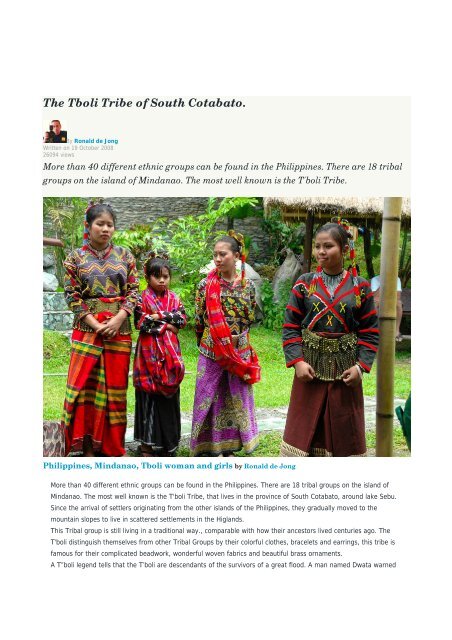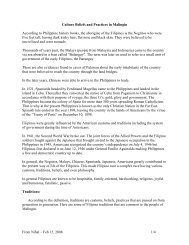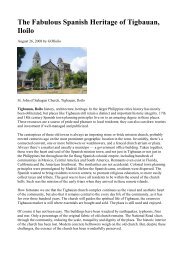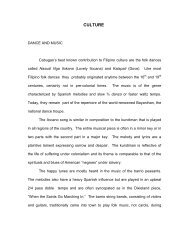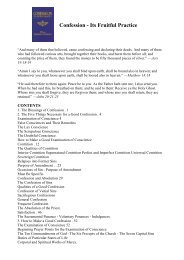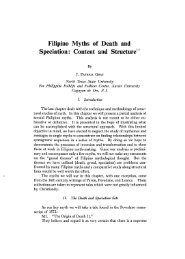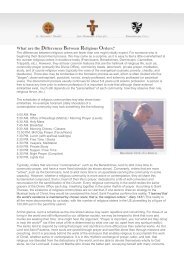The Tboli Tribe of South Cotabato - Ethnic Filipino groups
The Tboli Tribe of South Cotabato - Ethnic Filipino groups
The Tboli Tribe of South Cotabato - Ethnic Filipino groups
- No tags were found...
You also want an ePaper? Increase the reach of your titles
YUMPU automatically turns print PDFs into web optimized ePapers that Google loves.
<strong>The</strong> <strong>Tboli</strong> <strong>Tribe</strong> <strong>of</strong> <strong>South</strong> <strong>Cotabato</strong>.By Ronald de JongWritten on 19 October 200826094 viewsMore than 40 different ethnic <strong>groups</strong> can be found in the Philippines. <strong>The</strong>re are 18 tribal<strong>groups</strong> on the island <strong>of</strong> Mindanao. <strong>The</strong> most well known is the T'boli <strong>Tribe</strong>.Philippines, Mindanao, <strong>Tboli</strong> woman and girls by Ronald de JongMore than 40 different ethnic <strong>groups</strong> can be found in the Philippines. <strong>The</strong>re are 18 tribal <strong>groups</strong> on the island <strong>of</strong>Mindanao. <strong>The</strong> most well known is the T'boli <strong>Tribe</strong>, that lives in the province <strong>of</strong> <strong>South</strong> <strong>Cotabato</strong>, around lake Sebu.Since the arrival <strong>of</strong> settlers originating from the other islands <strong>of</strong> the Philippines, they gradually moved to themountain slopes to live in scattered settlements in the Higlands.This Tribal group is still living in a traditional way., comparable with how their ancestors lived centuries ago. <strong>The</strong>T'boli distinguish themselves from other Tribal Groups by their colorful clothes, bracelets and earrings, this tribe isfamous for their complicated beadwork, wonderful woven fabrics and beautiful brass ornaments.A T”boli legend tells that the T’boli are descendants <strong>of</strong> the survivors <strong>of</strong> a great flood. A man named Dwata warned
the people <strong>of</strong> an impending great flood. But the tribe refused to listen, except for two couples, La Bebe and LaLomi, and Tamfeles and La Kagef. Dwata told them to take shelter in a bamboo so huge they could fit inside and inthis way survive the flood. <strong>The</strong> story tells that the first couple are the ancestors <strong>of</strong> the <strong>Tboli</strong> and other highlandethnic <strong>groups</strong> <strong>The</strong> second couple descended the other <strong>Filipino</strong> indigenous <strong>groups</strong>.<strong>The</strong> <strong>Tboli</strong> culture is richly connected with and inspired by nature, their dances are a mimick from the action <strong>of</strong>animals such as monkeys and birds. <strong>The</strong> T’boli have a rich musical culture with a variety <strong>of</strong> musical instruments, butthe T'boli music and songs are not meant for entertainment only. <strong>The</strong> Tribal songs are a living contact with theirancestors and a source <strong>of</strong> ancient wisdom. <strong>The</strong> T’boli believe that everything has a spirit which must be respectedfor good fortune. Bad spirits can cause illness and misfortune.<strong>The</strong> Tnalak, the T’boli sacred cloth, made from abaca is the best known T’boli craft and is one <strong>of</strong> the tribestraditional textile, this cloth is exchanged during marriages and used as a cover during births. <strong>The</strong> T'boli women arenamed dreamweavers, another legend tells us that the Tnalak weaving was taught by a goddess named Fu Dalu ina dream and that women learn this ethnic and sacred ritual, based on tribal designs and cloth patterns throughtheir dreams. <strong>The</strong>se unique patterns are made with centuries-old practices and passed down from generation togeneration. This typical <strong>Tboli</strong> textile is history held in the hands <strong>of</strong> their makers and the rich cultural heritage can beseen through their creations, it shows the tribe’s collective imagination and cultural meanings<strong>The</strong> weaving is a very tedious job and requires much patience, a lot <strong>of</strong> creativity and a good memory to remenberthe particular designs. Men are not allowed to touch the chosen abaca fiber and materials used in the weavingprocess and the weaver should not mate with her husband in the time the cloth is woven, for it may break the fiberand destroy the design. At present the T’nalak products have become the signature product <strong>of</strong> the province <strong>of</strong><strong>South</strong> <strong>Cotabato</strong>.When visiting the friendly T”boli tribe in <strong>South</strong> <strong>Cotabato</strong> you will be in the midst <strong>of</strong> a distinctive and very wellpreserved culture that is keeping their characteristic, ancient traditions alive. A visit that will be an unforgettableand inspiring experience!
Mindanao, <strong>Tboli</strong> girl
Mindanao, female <strong>Tboli</strong> musicians
Mindanao, <strong>Tboli</strong> tribal dance
Mindanao, <strong>Tboli</strong> musiciansMindanao, young <strong>Tboli</strong> girlRef.: http://everywheremag.com/articles/1178


